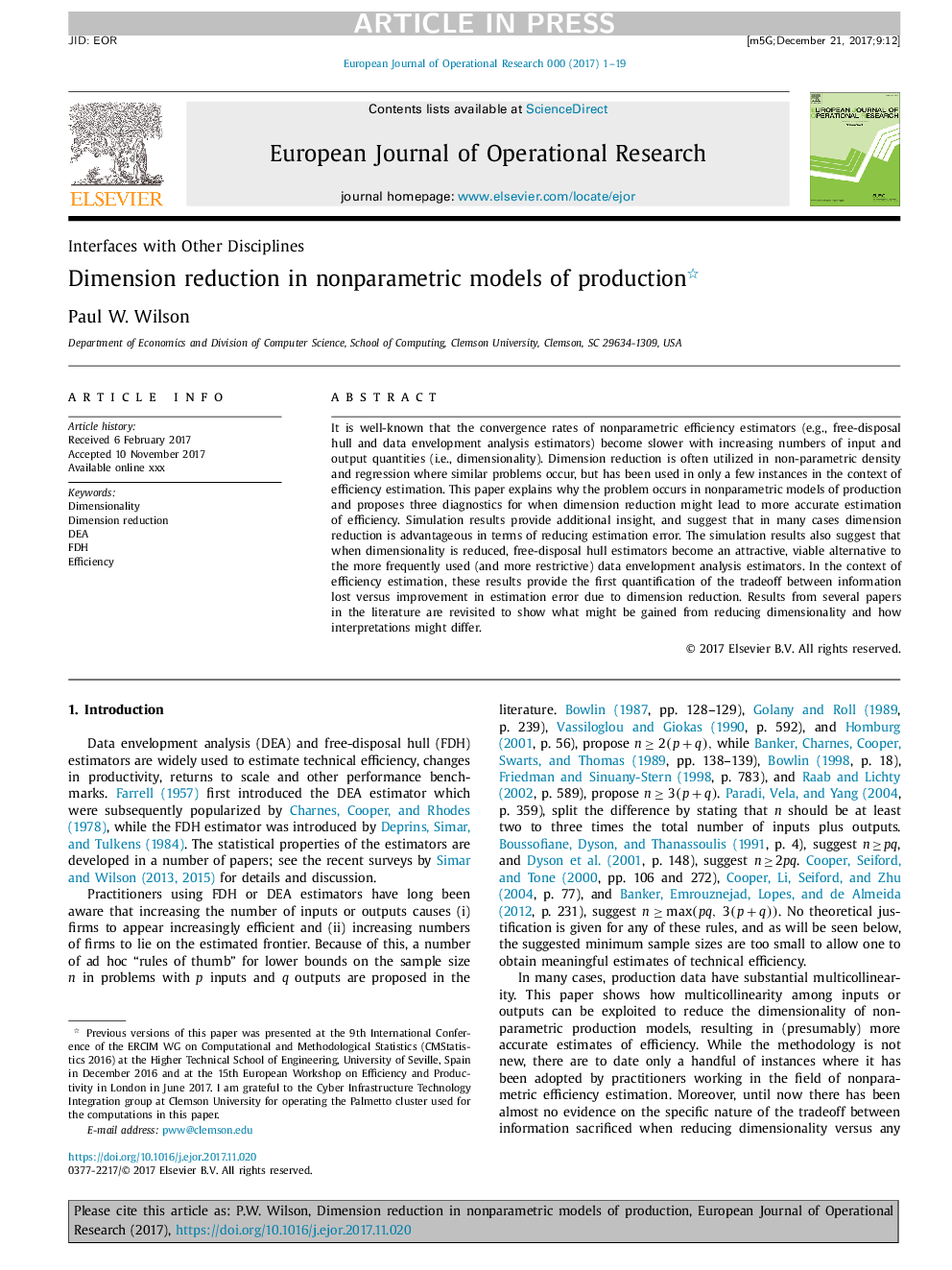| کد مقاله | کد نشریه | سال انتشار | مقاله انگلیسی | نسخه تمام متن |
|---|---|---|---|---|
| 6895082 | 1445936 | 2018 | 19 صفحه PDF | دانلود رایگان |
عنوان انگلیسی مقاله ISI
Dimension reduction in nonparametric models of production
ترجمه فارسی عنوان
کاهش ابعاد مدل های غیر پارامتری تولید
دانلود مقاله + سفارش ترجمه
دانلود مقاله ISI انگلیسی
رایگان برای ایرانیان
کلمات کلیدی
ترجمه چکیده
به خوبی شناخته شده است که با افزایش تعداد مقادیر ورودی و خروجی (یعنی ابعاد)، میزان همگرا برآوردگرهای کارآیی غیر پارامتری (به عنوان مثال، محاسبات بازده آزادسازی بدنه و تجزیه و تحلیل داده ها) کاهش می یابد. کاهش ابعاد اغلب در چگالی غیر پارامتری و رگرسیون که در آن مشکلات مشابه رخ می دهد، استفاده می شود، اما تنها در چند مورد در زمینه برآورد کارایی استفاده شده است. این مقاله توضیح می دهد که چرا مشکل در مدل های غیر پارامتری تولید اتفاق می افتد و سه تشخیص را برای زمانی که کاهش ابعاد ممکن است منجر به برآورد دقیق تر کارایی شود، پیشنهاد می کند. نتایج شبیه سازی بینش بیشتری را فراهم می کنند و نشان می دهد که در بسیاری از موارد کاهش ابعاد از لحاظ کاهش خطای تخمین سودمند است. نتایج شبیه سازی نیز نشان می دهد که هنگامی که ابعاد کاهش می یابد، برآوردگرهای تخریب مجدد آزاد تبدیل به یک جایگزین جذاب و قابل قبول برای برآوردگرهای تجزیه و تحلیل داده ها در اغلب موارد (و بیشتر محدود کننده) می شوند. در چارچوب برآورد کارایی، این نتایج نتایج کمیتی اول را در بین اطلاعات از دست داده در مقایسه با بهبود خطای تخمین به دلیل کاهش ابعاد ارائه می دهد. نتایج چندین مقاله در ادبیات مجددا مورد بررسی قرار می گیرند تا نشان دهند چه چیزی ممکن است از کاهش ابعاد و نحوه تفسیر ها متفاوت باشد.
موضوعات مرتبط
مهندسی و علوم پایه
مهندسی کامپیوتر
علوم کامپیوتر (عمومی)
چکیده انگلیسی
It is well-known that the convergence rates of nonparametric efficiency estimators (e.g., free-disposal hull and data envelopment analysis estimators) become slower with increasing numbers of input and output quantities (i.e., dimensionality). Dimension reduction is often utilized in non-parametric density and regression where similar problems occur, but has been used in only a few instances in the context of efficiency estimation. This paper explains why the problem occurs in nonparametric models of production and proposes three diagnostics for when dimension reduction might lead to more accurate estimation of efficiency. Simulation results provide additional insight, and suggest that in many cases dimension reduction is advantageous in terms of reducing estimation error. The simulation results also suggest that when dimensionality is reduced, free-disposal hull estimators become an attractive, viable alternative to the more frequently used (and more restrictive) data envelopment analysis estimators. In the context of efficiency estimation, these results provide the first quantification of the tradeoff between information lost versus improvement in estimation error due to dimension reduction. Results from several papers in the literature are revisited to show what might be gained from reducing dimensionality and how interpretations might differ.
ناشر
Database: Elsevier - ScienceDirect (ساینس دایرکت)
Journal: European Journal of Operational Research - Volume 267, Issue 1, 16 May 2018, Pages 349-367
Journal: European Journal of Operational Research - Volume 267, Issue 1, 16 May 2018, Pages 349-367
نویسندگان
Paul W. Wilson,
